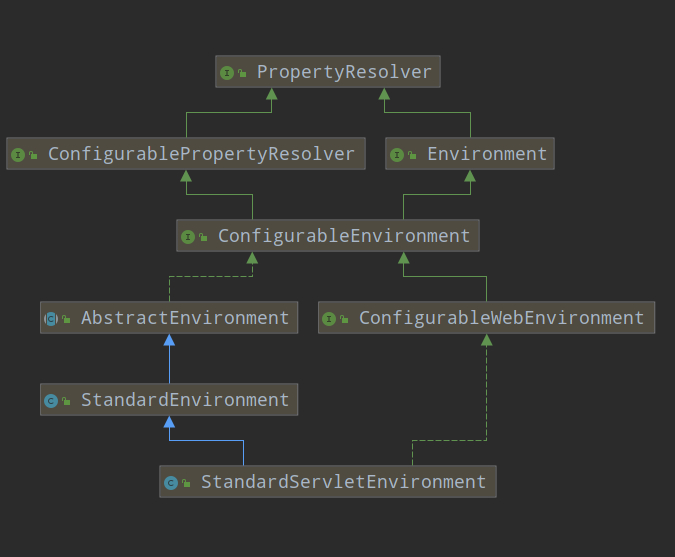您好,登錄后才能下訂單哦!
您好,登錄后才能下訂單哦!
SpringBoot的啟動流程有哪些,針對這個問題,這篇文章詳細介紹了相對應的分析和解答,希望可以幫助更多想解決這個問題的小伙伴找到更簡單易行的方法。
在IDE中啟動SpringBoot主類(XXXApplication)中的main方法
使用mvn spring-boot:run命令啟動
打成jar包之后使用java -jar xxx.jar運行
打成war包之后放在web容器中運行
2.SpringBoot啟動流程主要分為三步:
第一部分:SpringApplication初始化模塊,配置一些基本的環境變量,資源,監聽器,構造器;
第二部分:實現了應用具體的啟動方案,包括流程的監聽模塊,加載配置環境模塊以及創建上下文環境模塊
第三部分:自動化配置模塊,這個模塊是實現SpringBoot的自動配置
SpringBoot程序的主入口就是標注了@SpringBootApplication注解的類,該類中有一個main方法,在main方法中調用SpringApplication的run()方法,這個run()方法來啟動整個程序
@SpringBootApplication
public class CrmWebApiApplication extends SpringBootServletInitializer {
public static void main(String[] args) {
SpringApplication.run(CrmWebApiApplication.class, args);
}
}下面是@SpringBootApplication注解的頭部源碼
@Target(ElementType.TYPE)
@Retention(RetentionPolicy.RUNTIME)
@Documented
@Inherited
@SpringBootConfiguration
@EnableAutoConfiguration
@ComponentScan(excludeFilters = {
@Filter(type = FilterType.CUSTOM, classes = TypeExcludeFilter.class),
@Filter(type = FilterType.CUSTOM, classes = AutoConfigurationExcludeFilter.class) })
public @interface SpringBootApplication {這是一個組合注解,其中標注的注解主要有以下作用
@EnableAutoConfiguration: 開啟SpringBoot自動配置,在程序啟動時會自動加載SpringBoot的默認配置,如果有對一些參數進行配置,則會在程序啟動時或調用時進行追加或者覆蓋
@SpringBootConfiguration: 這個注解和@Configuration注解的作用一樣,用來表示被標注的類是一個配置類,會將被標注的類中一個或多個被@Bean注解修飾的方法添加到Spring容器中,實例的名字默認是方法名
@ComponentScan: 包掃描注解,默認掃描主類包路徑下的類
進入run()方法后的代碼如下:
/**
* Static helper that can be used to run a {@link SpringApplication} from the
* specified sources using default settings and user supplied arguments.
* @param sources the sources to load
* @param args the application arguments (usually passed from a Java main method)
* @return the running {@link ApplicationContext}
*/
public static ConfigurableApplicationContext run(Object[] sources, String[] args) {
return new SpringApplication(sources).run(args);
}這里會創建一個SpringApplication類的實例,進入SpringApplication類中可以看到構造方法里調用了一個initialize(sources)方法
/**
* Create a new {@link SpringApplication} instance. The application context will load
* beans from the specified sources (see {@link SpringApplication class-level}
* documentation for details. The instance can be customized before calling
* {@link #run(String...)}.
* @param sources the bean sources
* @see #run(Object, String[])
* @see #SpringApplication(ResourceLoader, Object...)
*/
public SpringApplication(Object... sources) {
initialize(sources);
}Initialize(sources)方法源碼如下:
@SuppressWarnings({ "unchecked", "rawtypes" })
private void initialize(Object[] sources) {
if (sources != null && sources.length > 0) {
//將sources設置到SpringApplication類的source屬性中,這時的source值只有主類
this.sources.addAll(Arrays.asList(sources));
}
//判斷是不是web程序,
this.webEnvironment = deduceWebEnvironment();
//從spring.factories文件中找出key為ApplicationContextInitializer的類進行實例化,然后設置到SpringApplciation類的initializers屬性中,這個過程也是找出所有的應用程序初始化器
setInitializers((Collection) getSpringFactoriesInstances( ApplicationContextInitializer.class));
//從spring.factories文件中找出key為ApplicationListener的類并實例化后設置到SpringApplication的listeners屬性中。這個過程就是找出所有的應用程序事件監聽器
setListeners((Collection) getSpringFactoriesInstances(ApplicationListener.class));
//找出main類,也就是SpringBoot項目的主類
this.mainApplicationClass = deduceMainApplicationClass();
}執行完初始化之后回到run()方法中,完整代碼如下:
/**
* Run the Spring application, creating and refreshing a new
* {@link ApplicationContext}.
* @param args the application arguments (usually passed from a Java main method)
* @return a running {@link ApplicationContext}
*/
public ConfigurableApplicationContext run(String... args) {
StopWatch stopWatch = new StopWatch();
stopWatch.start();
ConfigurableApplicationContext context = null;
FailureAnalyzers analyzers = null;
configureHeadlessProperty();
//創建應用監聽器
SpringApplicationRunListeners listeners = getRunListeners(args);
//開始監聽
listeners.starting();
try {
ApplicationArguments applicationArguments = new DefaultApplicationArguments(args);
//加載SpringBoot配置環境ConfigurableEnvironment,見2.2配置ConfigurableEnvironment
ConfigurableEnvironment environment = prepareEnvironment(listeners,applicationArguments);
//打印banner
Banner printedBanner = printBanner(environment);
//創建應用程序上下文,見2.3 創建應用程序上下文
context = createApplicationContext();
analyzers = new FailureAnalyzers(context);
prepareContext(context, environment, listeners, applicationArguments,printedBanner);
refreshContext(context);
afterRefresh(context, applicationArguments);
listeners.finished(context, null);
stopWatch.stop();
if (this.logStartupInfo) {
new StartupInfoLogger(this.mainApplicationClass)
.logStarted(getApplicationLog(), stopWatch);
}
return context;
}catch (Throwable ex) {
handleRunFailure(context, listeners, analyzers, ex);
throw new IllegalStateException(ex);
}
}加載SpringBoot配置環境ConfigurableEnvironment流程如下:
private ConfigurableEnvironment prepareEnvironment(
SpringApplicationRunListeners listeners,
ApplicationArguments applicationArguments) {
// Create and configure the environment
ConfigurableEnvironment environment = getOrCreateEnvironment();
configureEnvironment(environment, applicationArguments.getSourceArgs());
listeners.environmentPrepared(environment);
if (!this.webEnvironment) {
environment = new EnvironmentConverter(getClassLoader())
.convertToStandardEnvironmentIfNecessary(environment);
}
return environment;
}在加載配置環境的過程中會判斷是否是web容器啟動,如果是容器啟動會加載StandardServletEnvironment
private ConfigurableEnvironment getOrCreateEnvironment() {
if (this.environment != null) {
return this.environment;
}
if (this.webEnvironment) {
return new StandardServletEnvironment();
}
return new StandardEnvironment();
}StandardServletEnvironment類的繼承關系如下,StandardServletEnvironment

PropertyResolver接口是用于解析任何基礎源的屬性的接口,在加載完配置之后會將配置環境加入到監聽器對象SpringApplicationRunListeners中。
然后會創建應用上下文對象,具體代碼如下:
protected ConfigurableApplicationContext createApplicationContext() {
Class<?> contextClass = this.applicationContextClass;
if (contextClass == null) {
try {
contextClass = Class.forName(this.webEnvironment
? DEFAULT_WEB_CONTEXT_CLASS : DEFAULT_CONTEXT_CLASS);
}
catch (ClassNotFoundException ex) {
throw new IllegalStateException(
"Unable create a default ApplicationContext, "
+ "please specify an ApplicationContextClass",
ex);
}
}
return (ConfigurableApplicationContext) BeanUtils.instantiate(contextClass);
}方法會先顯式的獲取應用上下文對象,如果對象為空,再加載默認的環境配置,通過是否是webEnvironment進行判斷,默認選擇的是AnnotationConfigApplicationContext(注解上下文,通過掃秒注解來加載bean),然后通過BeanUtils來實例化應用上下文對象然后返回,ConfigurableApplicationContext類繼承關系如下:
這里推薦一下我的另一篇博客,不太懂ConfigurableApplicationContext的可以去看一下,https://juejin.im/post/5d72055f5188256bab4c0b6d

回到run()方法中,會調用prepareContext()方法將environment, listeners,applicationArguments, printedBanner等組件與上下文對象進行關聯
private void prepareContext(ConfigurableApplicationContext context,
ConfigurableEnvironment environment, SpringApplicationRunListeners listeners,
ApplicationArguments applicationArguments, Banner printedBanner) {
context.setEnvironment(environment);
postProcessApplicationContext(context);
applyInitializers(context);
listeners.contextPrepared(context);
if (this.logStartupInfo) {
logStartupInfo(context.getParent() == null);
logStartupProfileInfo(context);
}
// Add boot specific singleton beans
context.getBeanFactory().registerSingleton("springApplicationArguments",
applicationArguments);
if (printedBanner != null) {
context.getBeanFactory().registerSingleton("springBootBanner", printedBanner);
}
// Load the sources
Set<Object> sources = getSources();
Assert.notEmpty(sources, "Sources must not be empty");
load(context, sources.toArray(new Object[sources.size()]));
listeners.contextLoaded(context);
}然后會調用refreshContext()方法,實際調用org.springframework.context.support.AbstractApplicationContext.refresh()內的相關方法。這個方法里會進行redis,mybatis等的自動配置,包括spring.factories的加載,bean的實例化,BenFactoryPostProcessor接口的執行,BeanPostProcessor接口的執行,條件注解的解析,國際化功能的初始化等。
refreshContext()方法執行完畢之后會執行afterRefresh方法,當run()方法執行完之后Spring容器也就初始化完畢了
protected void afterRefresh(ConfigurableApplicationContext context,
ApplicationArguments args) {
callRunners(context, args);
}
private void callRunners(ApplicationContext context, ApplicationArguments args) {
List<Object> runners = new ArrayList<Object>();
runners.addAll(context.getBeansOfType(ApplicationRunner.class).values());
runners.addAll(context.getBeansOfType(CommandLineRunner.class).values());
AnnotationAwareOrderComparator.sort(runners);
for (Object runner : new LinkedHashSet<Object>(runners)) {
if (runner instanceof ApplicationRunner) {
callRunner((ApplicationRunner) runner, args);
}
if (runner instanceof CommandLineRunner) {
callRunner((CommandLineRunner) runner, args);
}
}
}
private void callRunner(ApplicationRunner runner, ApplicationArguments args) {
try {
(runner).run(args);
}
catch (Exception ex) {
throw new IllegalStateException("Failed to execute ApplicationRunner", ex);
}
}
private void callRunner(CommandLineRunner runner, ApplicationArguments args) {
try {
(runner).run(args.getSourceArgs());
}
catch (Exception ex) {
throw new IllegalStateException("Failed to execute CommandLineRunner", ex);
}
}關于SpringBoot的啟動流程有哪些問題的解答就分享到這里了,希望以上內容可以對大家有一定的幫助,如果你還有很多疑惑沒有解開,可以關注億速云行業資訊頻道了解更多相關知識。
免責聲明:本站發布的內容(圖片、視頻和文字)以原創、轉載和分享為主,文章觀點不代表本網站立場,如果涉及侵權請聯系站長郵箱:is@yisu.com進行舉報,并提供相關證據,一經查實,將立刻刪除涉嫌侵權內容。